|
 |
 Автор: Williams Автор: Williams
 Дата: 28 мая 2020 Дата: 28 мая 2020
 Просмотров: 1 050 Просмотров: 1 050 |
| |
F. Moukalled, L. Mangani, M. Darwish - The Finite Volume Method in Computational Fluid Dynamics
An Advanced Introduction with OpenFOAM and Matlab
Springer, 2016
pdf, 799 pages, english
ISBN: 978-3-319-16873-9
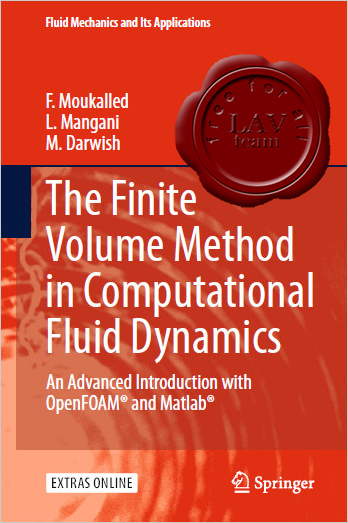
This textbook explores both the theoretical foundation of the Finite Volume Method (FVM) and its applications in Computational Fluid Dynamics (CFD). Readers will discover a thorough explanation of the FVM numerics and algorithms used for the simulation of incompressible and compressible fluid flows, along with a detailed examination of the components needed for the development of a collocated unstructured pressure-based CFD solver. Two particular CFD codes are explored. The first is uFVM, a three-dimensional unstructured pressure-based finite volume academic CFD code, implemented within Matlab. The second is OpenFOAM®, an open source framework used in the development of a range of CFD programs for the simulation of industrial scale flow problems.
With over 220 figures, numerous examples and more than one hundred exercise on FVM numerics, programming, and applications, this textbook is suitable for use in an introductory course on the FVM, in an advanced course on numerics, and as a reference for CFD programmers and researchers. |
| |
 Читать статью дальше (комментариев - 6)
Читать статью дальше (комментариев - 6)
| |
|
 |
 Автор: Williams Автор: Williams
 Дата: 26 мая 2020 Дата: 26 мая 2020
 Просмотров: 2 298 Просмотров: 2 298 |
| |
William Bajjali - ArcGIS for Environmental and Water Issues
Springer, 2019
pdf, 363 pages, english
ISBN: 978-3-319-61157-0
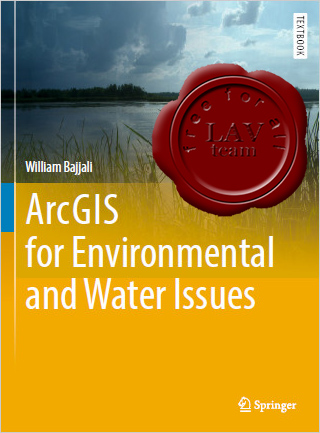
This textbook is a step-by-step tutorial on the applications of Geographic Information Systems (GIS) in environmental and water resource issues. It provides information about GIS and its applications, specifically using the most advanced ESRI GIS technology and its extensions.
Eighteen chapters cover GIS applications in the field of earth sciences and water resources in detail from the ground up. Author William Bajjali explains what a GIS is and what it is used for, the basics of map classification, data acquisition, coordinate systems and projections, vectorization, geodatabase and relational database, data editing, geoprocessing, suitability modeling, working with raster, watershed delineation, mathematical and statistical interpolation, and more advanced techniques, tools and extensions such as ArcScan, Topology, Geocoding, Hydrology, Geostatistical Analyst, Spatial Analyst, Network Analyst, 3-D Analyst. ArcPad, ESRI’s cutting-edge mobile GIS software, is covered in detail as well.
Each chapter contains concrete case studies and exercises – many from the author’s own work in the United States and Middle East. This volume is targeted toward advanced undergraduates, but could also be useful for professionals and for anyone who utilizes GIS or practices spatial analysis in relation to geology, hydrology, ecology, and environmental sciences. |
| |
 Читать статью дальше (комментариев - 17)
Читать статью дальше (комментариев - 17)
| |
|
 |
 Автор: Williams Автор: Williams
 Дата: 24 мая 2020 Дата: 24 мая 2020
 Просмотров: 1 663 Просмотров: 1 663 |
| |
Mario Paz, Young Hoon Kim - Structural Dynamics, Theory and Computation, Sixth Edition
Springer, 2019
pdf, 629 pages, english
ISBN: 978-3-319-94742-6
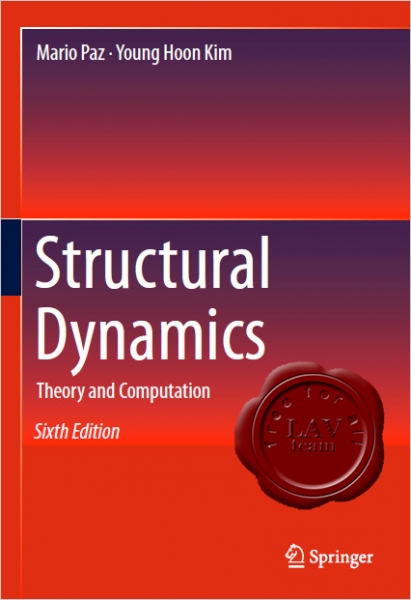
The sixth edition of Structural Dynamics: Theory and Computation is the complete and comprehensive text in the field. It presents modern methods of analysis and techniques adaptable to computer programming clearly and easily. The book is ideal as a text for advanced undergraduates or graduate students taking a first course in structural dynamics. It is arranged in such a way that it can be used for a one- or two-semester course, or span the undergraduate and graduate levels. In addition, this text will serve the practicing engineer as a primary reference.
The text differs from the standard approach of other presentations in which topics are ordered by their mathematical complexity. This text is organized by the type of structural modeling. The author simplifies the subject by presenting a single degree-of-freedom system in the first chapters, then moves to systems with many degrees-of-freedom in the following chapters. Finally, the text moves to applications of the first chapters and special topics in structural dynamics.
This revised textbook intends to provide enhanced learning materials for students to learn structural dynamics, ranging from basics to advanced topics, including their application. When a line-by-line programming language is included with solved problems, students can learn course materials easily and visualize the solved problems using a program. Among several programming languages, MATLAB® has been adopted by many academic institutions across several disciplines. Many educators and students in the U.S. and many international institutions can readily access MATLAB, which has an appropriate programming language to solve and simulate problems in the textbook. It effectively allows matrix manipulations and plotting of data. Therefore, multi-degree-of freedom problems can be solved in conjunction with the finite element method using MATLAB. |
| |
 Читать статью дальше (комментариев - 13)
Читать статью дальше (комментариев - 13)
| |
|
 |
 Автор: Williams Автор: Williams
 Дата: 22 мая 2020 Дата: 22 мая 2020
 Просмотров: 2 407 Просмотров: 2 407 |
| |
B. S. Grewal - Numerical Methods in Engineering and Science: C, C++, and MATLAB
Mercury Learning and Information, 2019
pdf, 951 pages, english
ISBN: 978-1-68392-128-8
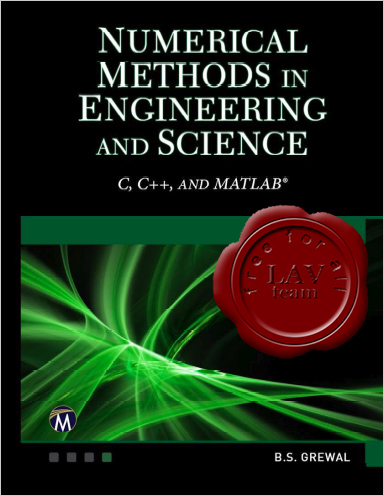
This book is intended as an introduction to numerical methods for scientists and engineers. Providing an excellent balance of theoretical and applied topics, it shows the numerical methods used with C, C++, and MATLAB.
The limitations of analytical methods in practical applications have led scientists and engineers to evolve numerical methods. We know that exact methods often fail in drawing plausible inferences from a given set of tabulated data or in finding roots of transcendental equations or in solving non-linear differential equations. There are many more such situations where analytical methods are unable to produce desirable results. Even if analytical solutions are available, these are not amenable to direct numerical interpretation.
The aim of numerical analysis is therefore, to provide constructive methods for obtaining answers to such problems in a numerical form.
With the advent of high speed computers and increasing demand for numerical solution to various problems, numerical techniques have become indispensible tools in the hands of engineers and scientists.
The input information is rarely exact since it comes from some measurement or the other and the method also introduces further error. As such, the error in the final result may be due to an error in the initial data or in the method or both. Our effort will be to minimize these errors, so as to get the best possible results. We therefore begin by explaining various kinds of approximations and errors which may occur in a problem and derive some results on error propagation in numerical calculations. |
| |
 Читать статью дальше (комментариев - 11)
Читать статью дальше (комментариев - 11)
| |
|
 |
 Автор: Williams Автор: Williams
 Дата: 20 мая 2020 Дата: 20 мая 2020
 Просмотров: 1 777 Просмотров: 1 777 |
| |
Laszlo Keviczky, Ruth Bars, Jeno Hetthessy, Csilla Banyasz -
Control Engineering & Control Engineering: MATLAB Exercises
Springer, 2019
pdf, 545+284 pages, english
ISBN: 978-981-10-8296-2
ISBN: 978-981-10-8320-4

This book offers fundamental information on the analysis and synthesis of continuous and sampled data control systems. It includes all the required preliminary materials (from mathematics, signals and systems) that are needed in order to understand control theory, so readers do not have to turn to other textbooks. Sampled data systems have recently gained increasing importance, as they provide the basis for the analysis and design of computer-controlled systems. Though the book mainly focuses on linear systems, input/output approaches and state space descriptions are also provided. Control structures such as feedback, feed forward, internal model control, state feedback control, and the Youla parameterization approach are discussed, while a closing section outlines advanced areas of control theory. Though the book also contains selected examples, a related exercise book provides Matlab/Simulink exercises for all topics discussed in the textbook, helping readers to understand the theory and apply it in order to solve control problems. Thanks to this combination, readers will gain a basic grasp of systems and control, and be able to analyze and design continuous and discrete control systems.
The MATLAB exercise book accompanies the textbook Control Engineering, providing a platform for students to practice problem solving in the analysis and design of continuous and discrete control problems reflected in the main textbook. The book starts off with a brief introduction to MATLAB, control toolbox and Simulink. Subsequent chapters include a short theoretical summary of the topic followed by exercises on solving complex problems using MATLAB commands. These exercises are ideal for students in computer laboratory classes. |
| |
 Читать статью дальше (комментариев - 13)
Читать статью дальше (комментариев - 13)
| |
|
 |
 Автор: Williams Автор: Williams
 Дата: 16 мая 2020 Дата: 16 мая 2020
 Просмотров: 2 024 Просмотров: 2 024 |
| |
Elliot Gindis, Robert Kaebisch - Up and Running with AutoCAD 2020 2D Drafting and Design
Academic Press, 2020
pdf, 557 pages, english
ISBN: 978-0-12-819862-9
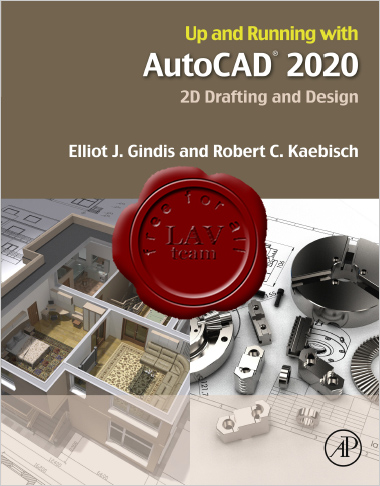
Up and Running with AutoCAD 2020 uses a combination of step-by-step instruction, examples and insightful explanations to emphasize core concepts and practical application of AutoCAD in engineering, architecture, and design. Equally useful in instructor-led classroom training, self-study, or as a reference, the book is written with the user in mind by long-time professional AutoCAD instructors based on what works in the industry and the classroom. The book focuses on 2D drafting and design, making it more appropriate for a one-semester course.
Key Features
- Strips away complexities and reduces learning AutoCAD to easy-to-understand concepts
- Teaches the essentials of AutoCAD first, immediately building student confidence
- Provides all basic commands documented step-by-step: What the student inputs and how AutoCAD responds is spelled out in discrete and clear steps with numerous screenshots
- Presents extensive supporting graphics and a summary with a self-test section and topic specific drawing exercises at the end of each chapter
- Covers the essentials of 2D AutoCAD, updated for the 2020 release
|
| |
 Читать статью дальше (комментариев - 10)
Читать статью дальше (комментариев - 10)
| |
|
 |
 Автор: Williams Автор: Williams
 Дата: 14 мая 2020 Дата: 14 мая 2020
 Просмотров: 887 Просмотров: 887 |
| |
Ryan Lee - CSWP Exam Preparation: All-In-One Guidebook with Practice Exams
BW Publications, 2020
pdf, 508 pages, english
ISBN: 979-8-639-14067-9
SOLIDWORKS Certifications are a benchmark to measure your knowledge and competency with SOLIDWORKS software. A certification helps you stand out from the crowd and showcases your expertise to businesses and professionals alike - a valuable asset in a competitive job market.
A few popular SOLIDWORKS Certifications include:
- CSWA: Certified SOLIDWORKS Associate
- CSWP: Certified SOLIDWORKS Professional
- CSWPA: Certified SOLIDWORKS Professional Advanced: Sheet Metal, Weldments, Surfacing, Mold Tools, Drawing Tools
- CSWE: Certified SOLIDWORKS Expert
- CEPA: Certified Enterprise PDM Administrator
This book, CSWP exam preparation: All-in-one guidebook with practice exams, is written to assist students in college and universities, engineers, and professionals who are interested in getting a certification of CSWP(Certified SOLIDWORKS Professional). There are so many books available for learning SOLIDWORKS, while there are very few books to help for CSWP exam preparation. To prepare for exams efficiently, future exam takers essentially need exam-oriented preparation books. There are some online/offline training programs. However, those are very expensive to prepare a CSWP exam. This book is divided into four parts. Part I covers introductory principles of CSWP, including fundamental knowledge of the CSWP exam. Part II covers the first segment of the CSWP exam mainly focusing on part modeling, including six practice exam sets. Also, key skills for passing the segment one exam are explained with various hands-on examples. Part III covers the second segment of the CSWP exam focusing on the configuration and design intent. Part IV covers the third segment focusing on the assemblies and mates. Organizing the book in this way is to help the students, engineers, and professionals to prepare the CSWP exam efficiently. This book has a significant number of pictorial descriptions of the steps with screenshots that a student should follow. |
| |
 Читать статью дальше (комментариев - 7)
Читать статью дальше (комментариев - 7)
| |
|
 |
 Автор: Williams Автор: Williams
 Дата: 12 мая 2020 Дата: 12 мая 2020
 Просмотров: 1 433 Просмотров: 1 433 |
| |
James Wilkes - Fluid Mechanics for Chemical Engineers, Third Edition
with Microfluidics, CFD, and COMSOL Multiphysics 5
Pearson, 2018
pdf, 807 pages, english
ISBN: 978-0-13-471282-6

Since most chemical processing applications are conducted either partially or totally in the fluid phase, chemical engineers need mastery of fluid mechanics. Such knowledge is especially valuable in the biochemical, chemical, energy, fermentation, materials, mining, petroleum, pharmaceuticals, polymer, and waste-processing industries.
Fluid Mechanics for Chemical Engineers: with Microfluidics, CFD, and COMSOL Multiphysics 5, Third Edition, systematically introduces fluid mechanics from the perspective of the chemical engineer who must understand actual physical behavior and solve real-world problems. Building on the book that earned Choice Magazine’s Outstanding Academic Title award, this edition also gives a comprehensive introduction to the popular COMSOL Multiphysics 5 software.
This third edition contains extensive coverage of both microfluidics and computational fluid dynamics, systematically demonstrating CFD through detailed examples using COMSOL Multiphysics 5 and ANSYS Fluent. The chapter on turbulence now presents valuable CFD techniques to investigate practical situations such as turbulent mixing and recirculating flows.
Part I offers a clear, succinct, easy-to-follow introduction to macroscopic fluid mechanics, including physical properties; hydrostatics; basic rate laws; and fundamental principles of flow through equipment. Part II turns to microscopic fluid mechanics:
- Differential equations of fluid mechanics
- Viscous-flow problems, some including polymer processing
- Laplace’s equation; irrotational and porous-media flows
- Nearly unidirectional flows, from boundary layers to lubrication, calendering, and thin-film applications
- Turbulent flows, showing how the k-ε method extends conventional mixing-length theory
- Bubble motion, two-phase flow, and fluidization
- Non-Newtonian fluids, including inelastic and viscoelastic fluids
- Microfluidics and electrokinetic flow effects, including electroosmosis, electrophoresis, streaming potentials, and electroosmotic switching
- Computational fluid mechanics with ANSYS Fluent and COMSOL Multiphysics
Nearly 100 completely worked practical examples include 12 new COMSOL 5 examples: boundary layer flow, non-Newtonian flow, jet flow, die flow, lubrication, momentum diffusion, turbulent flow, and others. More than 300 end-of-chapter problems of varying complexity are presented, including several from University of Cambridge exams. The author covers all material needed for the fluid mechanics portion of the professional engineer’s exam. |
| |
 Читать статью дальше (комментариев - 8)
Читать статью дальше (комментариев - 8)
| |
|
 |
 Автор: Williams Автор: Williams
 Дата: 9 мая 2020 Дата: 9 мая 2020
 Просмотров: 798 Просмотров: 798 |
| |
Benito Stradi-Granados - Cloud Computing for Engineering Applications
Springer, 2020
pdf, 384 pages, english
ISBN: 978-3-030-40444-4
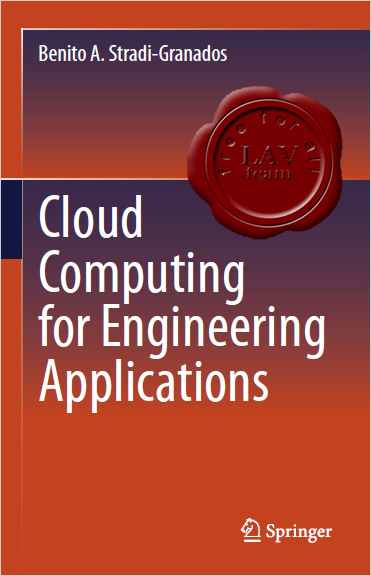
This book explains the use of cloud computing systems for engineering applications to satisfy the need for enterprise level, state-of-the-art computational capacities at an affordable cost. As huge costs are involved in the maintenance and timely renovation of computational capabilities, particularly for projects that require significant computational capacity, cloud services can achieve considerable savings for users and organizations engaged in engineering research and development. Dr. Stradi-Granados explains how to extract a maximum value from every dollar invested in cloud computer server. The types of facilities located around the world that lease their resources to customers interested in reducing the internal overhead and implementation time. The volume features chapters on model generation, motion studies, and prototyping is ideal for students, researchers, practitioners, and facility's managers across a range of engineering domains. |
| |
 Читать статью дальше (комментариев - 3)
Читать статью дальше (комментариев - 3)
| |
|
 |
 Автор: Williams Автор: Williams
 Дата: 7 мая 2020 Дата: 7 мая 2020
 Просмотров: 1 359 Просмотров: 1 359 |
| |
Oliver O’Reilly - Intermediate Dynamics for Engineers:
Newton-Euler and Lagrangian Mechanics, 2nd Edition
Cambridge University Press, 2020
pdf, 545 pages, english
ISBN: 978-1-108-49421-2

Suitable for both senior-level and first-year graduate courses, this fully revised edition provides a unique and systematic treatment of engineering dynamics that covers Newton-Euler and Lagrangian approaches. New to this edition are: two completely revised chapters on the constraints on, and potential energies for, rigid bodies, and the dynamics of systems of particles and rigid bodies; clearer discussion on coordinate singularities and their relation to mass matrices and configuration manifolds; additional discussion of contravariant basis vectors and dual Euler basis vectors, as well as related works in robotics; improved coverage of navigation equations; inclusion of a 350-page solutions manual for instructors, available online; a fully updated reference list. Numerous structured examples, discussion of various applications, and exercises covering a wide range of topics are included throughout, and source code for exercises, and simulations of systems are available online. |
| |
 Читать статью дальше (комментариев - 11)
Читать статью дальше (комментариев - 11)
| |
|
 |
| ПОИСК ПО САЙТУ |
 |
|
 |
| КАЛЕНДАРЬ | | |
 |
| « Октябрь 2025 » |
|---|
| Пн | Вт | Ср | Чт | Пт | Сб | Вс |
|---|
| | 1 | 2 | 3 | 4 | 5 | | 6 | 7 | 8 | 9 | 10 | 11 | 12 | | 13 | 14 | 15 | 16 | 17 | 18 | 19 | | 20 | 21 | 22 | 23 | 24 | 25 | 26 | | 27 | 28 | 29 | 30 | 31 | |
|
 | |
| |
|